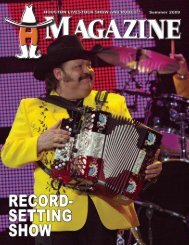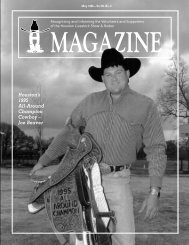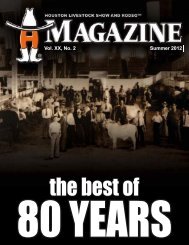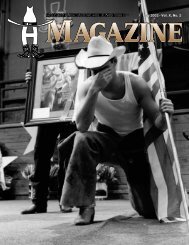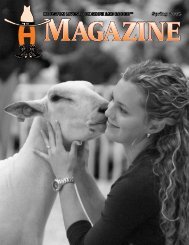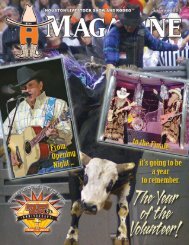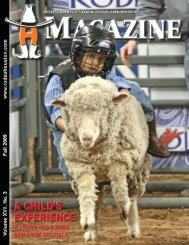HLSR Feb04-4 - Houston Livestock Show and Rodeo
HLSR Feb04-4 - Houston Livestock Show and Rodeo
HLSR Feb04-4 - Houston Livestock Show and Rodeo
You also want an ePaper? Increase the reach of your titles
YUMPU automatically turns print PDFs into web optimized ePapers that Google loves.
Fit to Be Tied<br />
By Bill R. Bludworth<br />
TIE-DOWN ROPING<br />
The rodeo sport of tie-down roping has its roots in the<br />
days of the working cowboy, who would rope a calf <strong>and</strong> tie it<br />
so that the calf could be medicated, castrated, br<strong>and</strong>ed or<br />
have a wound treated. What started off as a necessary<br />
part of working cattle has become a<br />
highly competitive <strong>and</strong> very popular<br />
event.<br />
Although previously called “calf roping,”<br />
the Professional <strong>Rodeo</strong> Cowboys<br />
Association officially changed the name to “tiedown<br />
roping” in early 2003 to reflect the true<br />
nature of the event. The animals used typically<br />
weigh 200 to 300 pounds — as<br />
much as or more than the cowboys<br />
who rope them.<br />
Calf ropers have the option of<br />
carrying one or two ropes for<br />
competition. Having the<br />
second rope enables a cowboy<br />
another try at a catch should<br />
he miss on the first attempt.<br />
In another effort to improve the<br />
event, as well as the perception<br />
of those who<br />
watch it, the option of a<br />
penalty fine or disqualification<br />
for a head-over-heels<br />
“jerk down” was instituted<br />
in 1999. According to Fred<br />
Whitfield, six-time world<br />
champion tie-down roper<br />
from Hockley, Texas, a<br />
roper normally can<br />
prevent a hard jerk-down<br />
by the way he h<strong>and</strong>les the<br />
slack in the rope as the<br />
horse comes to a stop.<br />
The rope can be flipped to<br />
one side or the other<br />
with the slack slowly<br />
released by the roper as<br />
he dismounts. This<br />
causes the roped animal<br />
to be stopped by turning<br />
it to the right or left<br />
rather than flipping it<br />
over backwards, thus<br />
reducing the chance for<br />
injury to the animal.<br />
The name of the game in tie-down roping is speed — the<br />
speed of the horse as well as the agility <strong>and</strong> speed of the roper.<br />
For the horse <strong>and</strong> rider team to do all that it does in so few<br />
seconds is phenomenal.<br />
In the tie-down roping event, the calf is held in a metal<br />
chute, with the roper on his horse backed into a rectangular<br />
box, which may be on either side of the chute, depending<br />
upon whether the roper is right- or left-h<strong>and</strong>ed. When the<br />
roper nods to release the calf, the chute gate is opened <strong>and</strong> the<br />
calf gets a head start. The clock begins to run at this point.<br />
Once the calf reaches a predetermined distance, a string<br />
attached to the calf trips a release that drops the “barrier” rope<br />
stretched across the front of the rider’s box, allowing the horse<br />
<strong>and</strong> rider to pass <strong>and</strong> chase after the calf.<br />
If the rider goes too soon <strong>and</strong> breaks the barrier, a 10-second<br />
penalty is added to his time. The rider tries to judge the<br />
speed of the calf so that he <strong>and</strong> the horse are moving forward<br />
quickly <strong>and</strong> hit the barrier at the instant it is tripped by the<br />
calf.<br />
Once the horse <strong>and</strong> rider get close enough to the running<br />
calf, the rider throws a loop that l<strong>and</strong>s around the calf’s neck.<br />
The horse stops quickly, <strong>and</strong> the roper dismounts <strong>and</strong> controls<br />
the slack while he sprints toward the calf. Once he reaches<br />
the calf, he “flanks” it by lifting it off its feet so that he can<br />
throw it to the ground on its side. Once the calf is down, the<br />
roper kneels on it to hold it down while he uses a short length<br />
of rope, called a “pigging string,” to tie three of the calf’s legs<br />
together. Any catch on a calf is a legal catch, but catching one<br />
or more legs makes it difficult to tie it down.<br />
While all this is going on, the horse must keep the rope<br />
taut but not drag the calf. When the roper is finished tying the<br />
calf’s legs, he throws his h<strong>and</strong>s up to signal completion of his<br />
run. The roper then returns to his horse <strong>and</strong> rides forward to<br />
allow the rope to go slack. The calf must remain tied for six<br />
seconds in order for the roper to have a qualifying run.<br />
The fastest official time in this event, 5.7 seconds,<br />
occurred when the roper’s horse never left the box. Typical<br />
times in tie-down roping are in the 7- to 9-second range.<br />
Many variables in the trade of professional ropers are controllable.<br />
The type of saddles, spurs, stirrups, ropes, boots<br />
<strong>and</strong>, of course, horses that are used all can affect a tie-down<br />
roper’s performance, time <strong>and</strong> income. First of all, he needs a<br />
fast, strong horse — most often a Quarter Horse, which is<br />
capable of fast starts <strong>and</strong> speed over a short distance. The<br />
6






